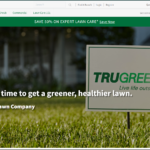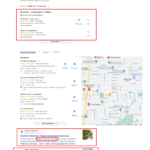Kentucky bluegrass is one of the most widely used cool-season grasses and is prevalent in lawns and play turfs in the northern two-thirds of the United States.
The reason for its popularity is its ability to spread and recover quickly from stress. Kentucky bluegrass can remain dormant during droughts and other stressful conditions and then bounce back quickly making your lawn lush green in the seasons. This quality makes it helpful when you have high foot or pet traffic on the grass or have patches on your lawn.
Being a cool-season grass, it doesn’t tolerate high heat and shade well but is aggressive and can easily handle foot traffic and dog foot traffic.
Kentucky bluegrass requires abundant watering since it develops thatch due to its shallow roots, causing water to run off. This grass becomes maintenance-heavy in summer and requires proper care and nurturing.
It is ideal for sports because it is not bunch forming and spreads horizontally. It forms a dense, thick turf, giving the turf a consistent surface appearance.
How to identify Kentucky Bluegrass
The leaves of the bluegrass plant are narrow and spreading but are bundled together towards the base.


It spreads through its rhizomes (underground shoots) and shallow lawn roots, differentiating it from other grass types. It does not form a bunch like tall fescue. It spreads so that the lawn looks like a consistent and level surface.
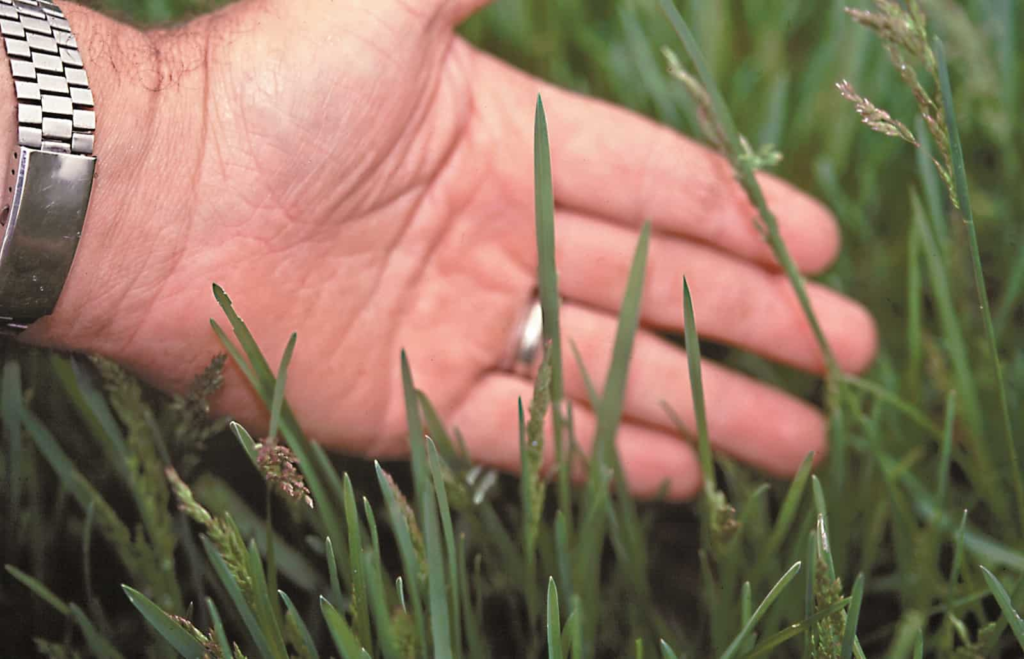
The blades of this grass are V-shaped and are long and narrow with boat-shaped tips.

You can identify by its dark green color with a tint appearance of blue hue.
The leaves also have “train tracks” in the middle of the lead if you look closely.
Kentucky Bluegrass varieties
There are over 100 varieties of this grass. Some popular ones along with their most important benefit are below:
| Kentucky bluegrass variety | Benefit |
|---|---|
| Midnight | rich dark green color, low growth habit |
| Skye | good traffic resistance, heat, drought, and subfreezing temperatures tolerant |
| Award | close mowing, built for sports, works well in transition zones |
| Shamrock | Aggressive, crowd out weed, tolerates heavy foot traffic |
| Baron | Dwarf-type bluegrass, high sending vigor, medium green color |
| Kenblue | Fine-bladed, shade-tolerant, green year-round |
| Kentucky 31 (aka KY 31) | Drought tolerance and persistence. |
Some other varieties to name them include Adelphi, Bristol, Nugget, Glade, Adelphi, Vatnage, and Warrens A-34.
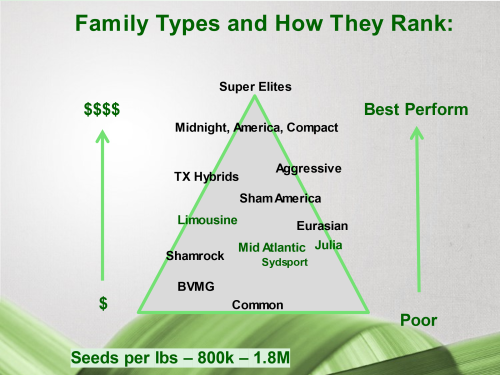
Quick Facts about Kentucky Bluegrass
| Characteristic | Kentucky Bluegrass |
|---|---|
| Type | Cool season grass |
| Cold tolerance | High |
| Heat tolerance | Low |
| Mowing height | 1 inch to 3 inches (5 cm to 7 cm) |
| Grows up to | 24 inches tall and 6 inches wide (90 cm and 15 cm) |
| USDA zones | 3 to 9 |
| Native or non-native | Non-native |
| Lifespan | Perennial (Year-round) |
| Thatch formation | High thatch formation |
| Scientific name | Poa Pratensis L. |
| Foot traffic tolerant | Yes |
| Dog traffic tolerant | Yes |
| Germination from seed | 3-4 weeks |
| Can be grown by | Seeding, sodding |
| Soil requirements | slightly acidic, well-drained |
| Water requirements | High |
| Shade tolerance | Low |
| Drought tolerance | Morderate (Goes dormant) |
| Growth months | Spring and fall |
Soil requirements
KBG does well in loamy soils (a mixture of sand, silt, and clay). It does well in loamy because loamy is not too loose to retain any water and also not too compacted which presents waterlogging.
If your soil is too sandy, you can add compost or organic matter and if it is too clayey, then add sand or gravel. For amendments, you can choose compost perlite.
The ideal soil temperature for Kentucky bluegrass seed to germinate is 50-60 degrees Fahrenheit.
The best soil conditions for this type of grass include well-drained and medium-textured soil.
The soil should be rototilled with organic matter such as compost, and yard waste to provide a slow-release fertilizer for KBG to grow.
Kentucky bluegrass requires an optimal 6 to 7 soil pH for cultivation. It can tolerate 5.4 to 7.3 pH.
If the pH is below 5.8, you can apply lime before planting. The alternative is to topdress with a counter pH. To use lime, use 1 to 2 tons/acre on normal soils and less on sandy soils. Clayey soil requires a higher rate from 1.5 to 2.5 tons/acre.
If the pH is higher than 7, then sulfur treatments are recommended.
It doesn’t do well in highly compacted soil. Aerate if your soil is too compacted.
Planting Kentucky bluegrass
The best time to plant the seed is in September and in spring. If you prefer sodding rather than growing it yourself using seed, then you can plant Kentucky bluegrass using sod in September end or in spring.
For planting, soil should be rototilled at least six inches to add oxygen, de-compact, and allow water to reach to roots.
KBG is a self-spreading grass, which means that it can spread quickly using rhizomes to form green-looking turf. This also means that you do not need to seed bare spots until they are bigger than 1 square foot.

Seed: 2-3 pounds per 1000 sq ft.
New seed requires light, 2-3 times per day watering for the first 2 weeks.
The planting should be done at one-fourth to half-inch depth in the soil.
Water requirements
This grass requires 2 inches of water per week if you want to keep it green and growing during the summer months. During non-summer months, 1 inch per week would do fine.
The best time to water KBG is in the early morning.
During drought periods when you have lawn irrigation problems, you can allow this grass to go dormant by watering it 1 inch every 2-3 weeks for it to just be alive and recover when you want it to grow.
The high water requirement during summer is due to built-up thatch. Thatch prevents water from going into the roots of the plant and doesn’t let the water hold, due to which KBG requires frequent watering.
When do I water my lawn?
When the turf begins to turn a bluish cast, or when walking across the lawn leaves lingering footprints, the lawn needs water.
To know when your KBG grass needs water, look at the leaves. Are they shriveled and have a pine-needle appearance? Is the color faded and greyish rather than dark green? If yes, then you know it’s time to water your grass.
During spring and fall, there is a special need for water timings for your grass. Spring and fall are when your lawn will be most susceptible to diseases and since those diseases are affected by watering during morning or dawn, it is best to water during the day.
If you have a watering ban during the daytime due to water shortage, then do it at the end of times of the ban ie. Right after morning or before evening.
Mowing requirements
Weekly mowing with a 2-inch cutting height is generally considered the best for Kentucky bluegrass. The blades must be shard enough to not pull up the seedlings from the soil.
If you mow regularly within an inch of grass growth, you will not need to collect grass clippings. Small grass clippings less than one inch decompose and give nutrients to the grass.
Mowing to the correct height also depends on sun exposure to the KBG. If you have a lot of sun exposure to your lawn, then mow to 2-inch height. If you have some shade, mow to 3-inch height.
Apart from that, the season also plays a factor in keeping the height just right. For example, June, July, and August are off-season for KBG, so a mowing height of 3-4 inches is recommended in these months. See the maintenance calendar below for complete details.
If you mow too low, weeds can creep in, weakening your grass and making it more prone to damage. Additionally, it’s not recommended to cut more than 1/3.
Mowing is suggested when the grass is dry. If you mow KBG when it’s wet, your blades will get damaged and your clippings will form clumps.
Fertilizer requirements
Kentucky bluegrass requires a higher level of nitrogen when you’re first planting it. you will need 5-6 pounds of nitrogen in the first year and then subsequently need 2-3 pounds for maintenance in the first year.
It is best to use a slow-release nitrogen if you’re doing the application once. But otherwise to avoid burning your grass, do not apply more than 1 pound of nitrogen in a single session for a 1000 ft and water it down.
If the soil is alkaline and your grass blade color has yellow pigment, you can use ferrous sulfate 2 oz. per 1000 square ft. Also at this point, do not use fertilizers that have phosphorus until extremely required.
Other relevant fertilizers for KBG are phosphorus, potassium, calcium, magnesium, and sulfur.
To keep your Kentucky bluegrass green all year round, you should fertilize it 3 to 4 times in a year. You should consult a local pro to know the fertilizer balancing along with combinations suitable at the time. Balancing means having a proper ratio of nitrogen (N), phosphorus (P), and potassium (K) in the mix.
Your pro might suggest using a high nitrogen fertilizer for root development in October while they may suggest fertilizer and pesticide in April.
What happens when you do not fertilize KBG
If you do not fertilize Kentucky bluegrass, your lawn will look light green with stands of brown and yellow in the mix. You also risk the chance of weeds overpowering your grass.
Best fertilizing schedule for KBG
Winters (Oct – Feb): Use soluble fertilizer with an 18-0-4 mix. Use 1 pound of nitrogen for 1000 sq ft.
Spring (Apr-May): In the spring, use a mixture such as 12-4-8 with slow-release nitrogen. Use 1.5 pounds of nitrogen per 1000 sq ft.
Fall (Sept): use 12-0-12 with slow-release nitrogen. Apple 1.5 pounds nitrogen per 1000 sq ft.
Always remember to water your lawn after fertilizer application to avoid undesirable burning or patches.
Mixing with other grasses
To best use the aggressive qualities of Kentucky bluegrass is most often mixed with 15% perennial ryegrass.
KBG is also mixed often with turf-type tall fescue to increase sod strength with tall fescue dominating the mix.
Some common mixtures that are successful depending on your zone:
- Blue Resilience Tall Fescue & Kentucky Bluegrass Mixture
- Bluemuda – Kentucky bluegrass + Bermuda
Diseases, Weeds and Pest problems
Diseases
Common diseases found in Kentucky bluegrass: Grey snow mold, Necrotic Ringspot, Strip smut, Fusarium blight in the transition zone, Helminthosporium leaf spot disease, rust, and Powdery mildew
Powdery mildew often appears during early spring due to cool, humid, and shade due to clouds and temperatures between 60-70 degrees. One way to identify it is to see if your grass has powdery spots on leaves.

Stripe rust forms when the temperatures hit 70-75 degrees and there is rain or dew in the atmosphere. You’ll be able to spot it when you see the leaves and stems having yellow to orange stripes. This generally happens due to the high acidity of the soil can be reduced with sulfur.

Snow mold often occurs if you leave the grass clippings for the first season. It is a good idea to remove the first batch. You can leave the grass clippings when you mow for the 3rd or 4th time after the winter season.
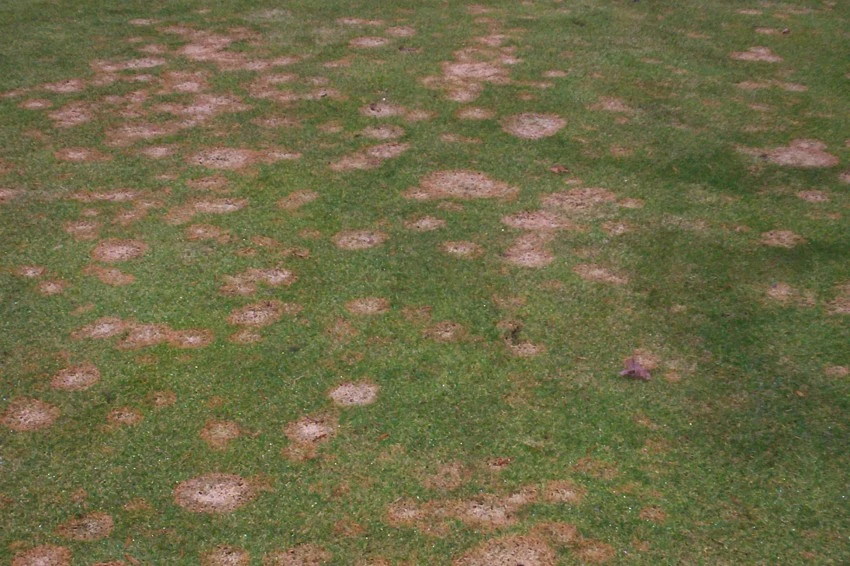
These diseases occur from July to October.
Generally, you do not need to predict when a disease will occur. You should keep an eye on anything abnormal. Many diseases do not require treatment. You just need to wait until they run their course and your lawn patches go back to normal.
Weed control
The most common weeds plaguing KBG are annual bluegrass, crabgrass, dandelions, clover, and nimblewill.
KBG is generally an aggressive species, so it dominates most weeds when it’s growing. There is a need to control weeds when you are first planting Kentucky bluegrass on your lawn.
You might need to apply herbicide depending on the season and weeds that grow in your area. Other common weeds include cheatgrass, rattail fescue, common groundsel, prickly lettuce, common mallow, dog fennel, Rrdstem filaree, curly dock, shepherd’s purse, other mustards, and quackgrass.
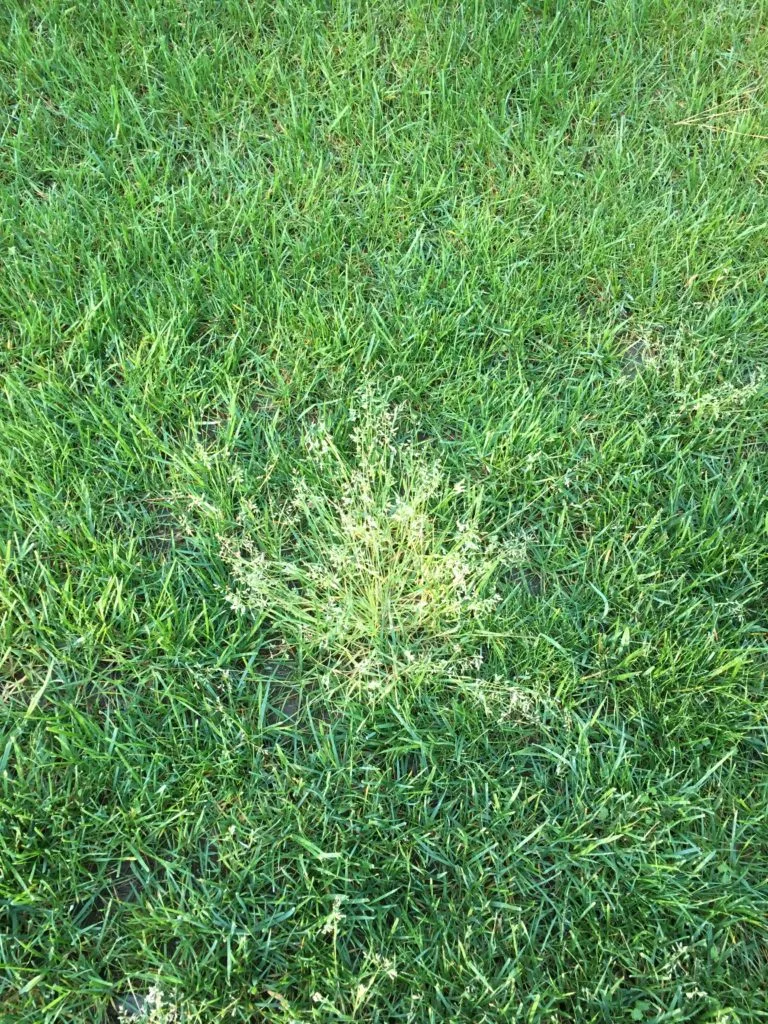
It is OK to leave clover in your KBG lawn, since after mowing, dead clover helps with nitrogen in the soil though it is a personal choice for everyone.
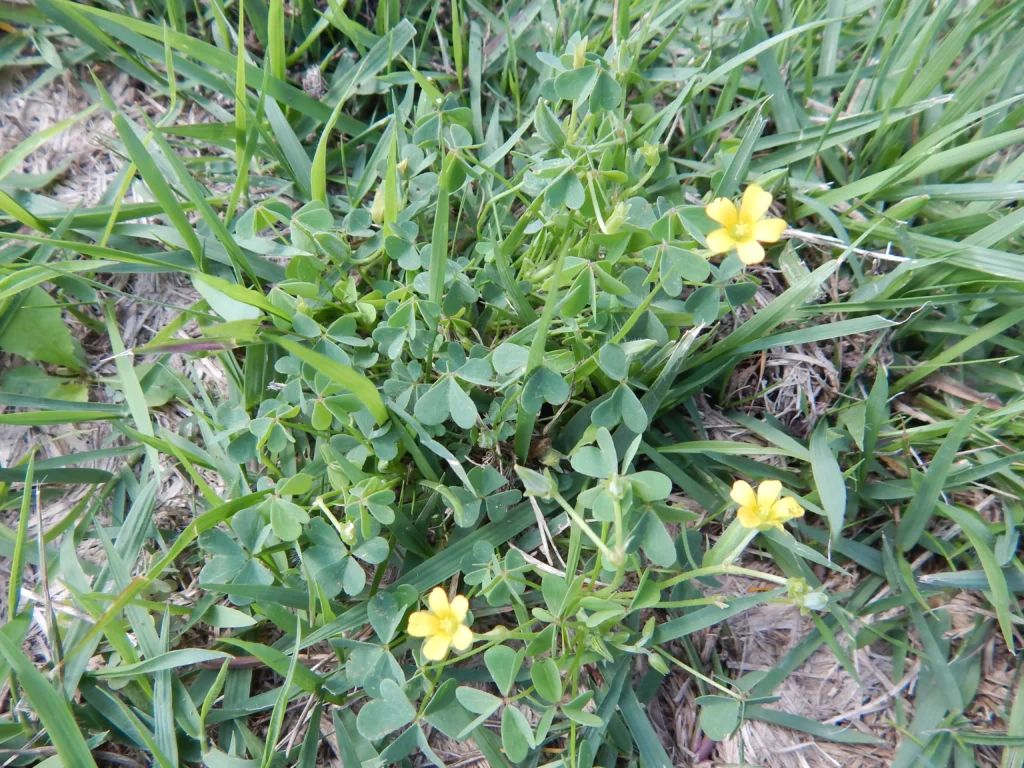
This grass being a cool season grass has the most chance of getting dominated by weeds in the summers. The best way to avoid it is by actively maintaining your lawn.
Use pre-emergence weed control for weeds like henbit. Pre-emergence weed control creates a barrier between your soil and weed seeds that seek to germinate when conditions for them are met. These are good when you want to prevent weeds from growing. They are generic and provide blanket coverage for perennial weeds.

If you already have some weeds growing in your KBG lawn, use post-emergence weed control. For this, you need to first identify the type of weeds growing. This is required because post-emergence mixes are available for specific types of weeds and they do not provide a blanket coverage like pre-emergence ones.
What if I use non-selective weed control on my lawn?
Post emergence killers do not affect dormant plants. So if you use a non-selective herbicide when you Kentucky bluegrass is dormant (in winters) and weeds are active, then you do not risk loosing your grass.
Pest control
Common pests: Winter grain mites, white grubs, billbugs, sod webworms, beetles and crickets.
How do i spot pest damage in my lawn?
Look for leaves that looks like they’ve been eaten by pests. Otherwise look for irregular shaped patches or brown grass.
Most pests are not harmful to your grass. They only need insecticide if they have a large enough population to harm your lawn. You can have insecticide treatments once a year which should be enough to prevent large growth of pests.
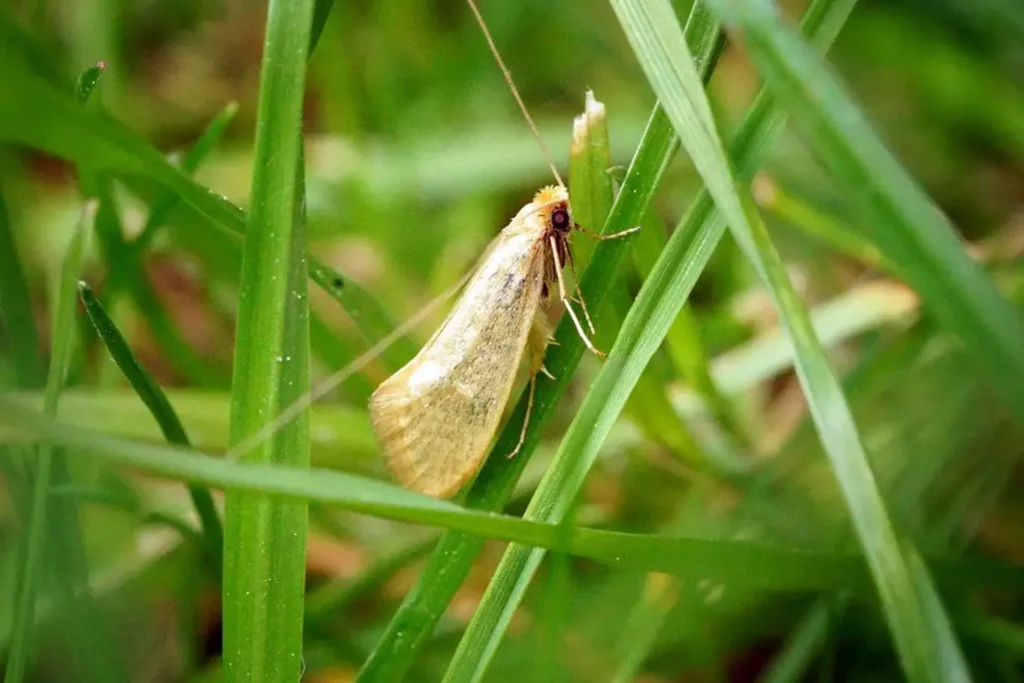
Depending on the type of insects on your lawn, identify and apply treatments accordingly. Treatment for each bug/worm/mile etc is out of the scope of this article.
Maintenance Calendar with activities for KBG
March, April, May
Mowing
Mow slightly lower than you would in the fall. This would allow your grass to be dense and be better off in fighting weeds.
Mow at a height of 2-3 inches.
Remove lawn clippings for the first two mows. Leave the grass clippings in 3rd or 4th mow activity.
Watering
Water 0.25 inches every alternate day. Water to a soil depth of 4 to 6 inches.
Depending on your soil, you can increase or decrease the amount of water you put into your lawn. A more sandy composition requires more water while Clayey soils require less.
Fertilisation
Apply around 0.5 pounds of nitrogen in March.
Weed control
Apply a crabgrass weed control (pre-emergent such as Dimension) before your soil temperature reaches 50 degrees. If you’ve just seeded or overseeded, skip the pre-emergent.
If goosegrass and foxtails are also a problem in your area, then you need to use a mix for these as well.
Leaf removal
Remove dead grass leaves accumulated from winters to allow sunlight to reach the soil surface. This will allow your grass to grow earlier and be completely season-ready when summer arises.
June, July, August
Mowing
Mow to the height of 4 to 5 inches.
Watering
Since you’ll have rainfall at this time, only water when needed. During summers, Kentucky bluegrass needs about 3 inches of water per week. It is best to water 1 inch every alternate day.
If you’re letting your grass go dormant, water every two weeks.
Fertilisation
Fertilize with more iron content in the mix. Apply 0.5 pounds of nitro per 1000 square feet.
Pest control
Add pest control application for bugs and grubs. The best time for adding a pest control treatment is in June and after rainfall.
Apply fungicide when you see brown patches in your KBG lawn.
September, October, November
Mowing
Mow to 2-3 inches in height. You will need to keep a check on the height as your grass will stop growing until late November.
Watering
Water 0.25 inches every alternate day. Water to a soil depth of 4 to 6 inches. You will need to decrease your water application every 2 weeks.
Fertilisation
Apply fertilization in two coats. One in September and another in early November.
Weed control
Apply treatments to control henbit or other common broadleaf weeds.
Overseeding
Overseed existing lawn with your relevant Kentucky bluegrass seed variety. Should be done along with your fertilizing application a month before frost.
Aeration
If your soil seems compacted, aerate using core plug aerators.
Dethatching
Along with aeration, dethatch.
Leaf Removal
Remove leaves and grass clipping to avoid disease spreading.
December, January, February
Mowing
If you do not have frost, mow to 3 inches.
Winter flush
Check for de-icing salt damage and flush with water.
You
- Do not walk on frosted leaves. It might damage them.
- Do not walk on your lawn when it is wet. It will cause your soil to compact easily and KBG doesn’t do very well in compacted soils.
Benefits
- KBG helps prevent soil erosion and compaction in your lawn.
- It keeps the ground cooler than bare soil.
- Ideal for playing in the yard
- It has low pollen levels.
FAQs
Should I do snow seeding on my Kentucky bluegrass lawn?
Snow seeding KBG is not a good idea. When snow melts your seeds will trickle down but germinate in spring. The new plants might not be mature enough to survive in the following summer heat.
In addition, if you leaf removal just after winter to remove dead grass leaves, you might undo the seeding that you previously did.
Kentucky bluegrass vs other native species: good or bad?
Since Kentucky bluegrass is aggressive in growth, it subdues other native species on your lawn. It has a strong root system and it forms a strong thatch thereby completing its nutritional requirements from the soil, but hindering native species growth due to thatch formed.
Does KBG help in erosion control?
Because Kentucky bluegrass spreads through the rhizome and is connected, the dense turf helps with erosion control.
How do I repair bare spots in my Kentucky bluegrass lawn?
To repair thinning or empty patches of the KBG lawn, use sod to patch the area by removing the soil 3 inches deep. You can also overseed the patch and fertilize. It is imperative that you find out the reason for those patches or else they’ll occur again.
Is Kentucky bluegrass pet-friendly?
KBG is non-toxic to dogs. It can also tolerate moderate foot traffic so you can let your pets roam on your lawn. Make sure to water dog pee, as it might cause patches. Don’t worry about any damage to your lawn though, as Kentucky bluegrass can heal itself pretty quickly.
Is KBG gardener friendly?
It is a personal preference. KBG is generally considered garden enthusiast-friendly because it can stand foot traffic, can be overwatered, and can go dormant during droughts so it’s easy to manage. One thing that is not good about KBG like other grasses is that it is not pollination friendly. So some enthusiasts generally prefer Yarrow as an alternative.
Can Kentucky bluegrass cause pollen allergy?
Yes, KBG can sometimes cause a runny nose, and itchy eyes during March, April, and May. This is not a problem for most people in the States though.
Latest research into Kentucky bluegrass
References
- Etter, A. G. (1951). How Kentucky Bluegrass Grows. Annals of the Missouri Botanical Garden, 38(3), 293. doi:10.2307/2394639
- Schery, R. W. (1965). This remarkable Kentucky bluegrass. Annals of the Missouri Botanical Garden, 52(3), 444-451.
- Palit, R., Gramig, G., & DeKeyser, E. S. (2021). Kentucky bluegrass invasion in the northern Great Plains and prospective management approaches to mitigate its spread. Plants, 10(4), 817.
- Mohlenbrock, R. H., Jr., USDA NRCS Rose Lake Plant Materials Center, USDA NRCS, USDA, US Department of Agriculture, & Bush, T. (1989). Plant fact sheet [Plant Fact Sheet]. http://plants.usda.gov
- Kentucky Bluegrass, Poa pratensis L. (2010, March 15). College of Agricultural Sciences. https://agsci.oregonstate.edu/beaverturf/kentucky-bluegrass-poa-pratensis-l
- UC Healthy Lawns—Turf adaptations and tolerances, not adapted to hot climates. (n.d.). https://ipm.ucanr.edu/TOOLS/TURF/TURFSPECIES/charlowht.html
- USDA Plants Database. (n.d.). https://plants.usda.gov/home/plantProfile?symbol=POPR
- Gibeault, V. A., Jr., Cockerham, S. T., & Autio, R. (1993). An evaluation of tall fescue and Kentucky bluegrass mixes. In COOPERATIVE EXTENSION UNIVERSITY OF CALIFORNIA, COOPERATIVE EXTENSION UNIVERSITY OF CALIFORNIA: Vol. Volume 43 1, 2, 3 and 4. https://turfgrass.ucr.edu/sites/default/files/2023-08/ctc43_1234.pdf
- Kentucky Bluegrass Lawns. (n.d.). https://www.ford.k-state.edu/lawn-garden/kentucky-bluegrass.html
- Turfgrass Disease Pests – Kentucky Pesticide Safety Education. (n.d.). https://www.uky.edu/Ag/Entomology/PSEP/11pests2diseaset.html
- Richmond, D. (n.d.). MANAGING BILLBUGS IN TURFGRASS. In Turfgrass Insects. https://extension.entm.purdue.edu/publications/E-266.pdf
- Munshaw, G., Vincelli, P. C., & University of Kentucky. (2014). Considering the environment in the maintenance of your Kentucky lawn: A season by season approach. In University of Kentucky & Agriculture and Natural Resources Publications Cooperative Extension Service, Agriculture and Natural Resources Publications. https://uknowledge.uky.edu/cgi/viewcontent.cgi?article=1170&context=anr_reports
- Brede, A. D. & JACKLIN SEED COMPANY. (n.d.). MIXING KENTUCKY BLUEGRASS AND PERENNIAL RYEGRASS. https://archive.lib.msu.edu/tic/mitgc/article/1990184.pdf







